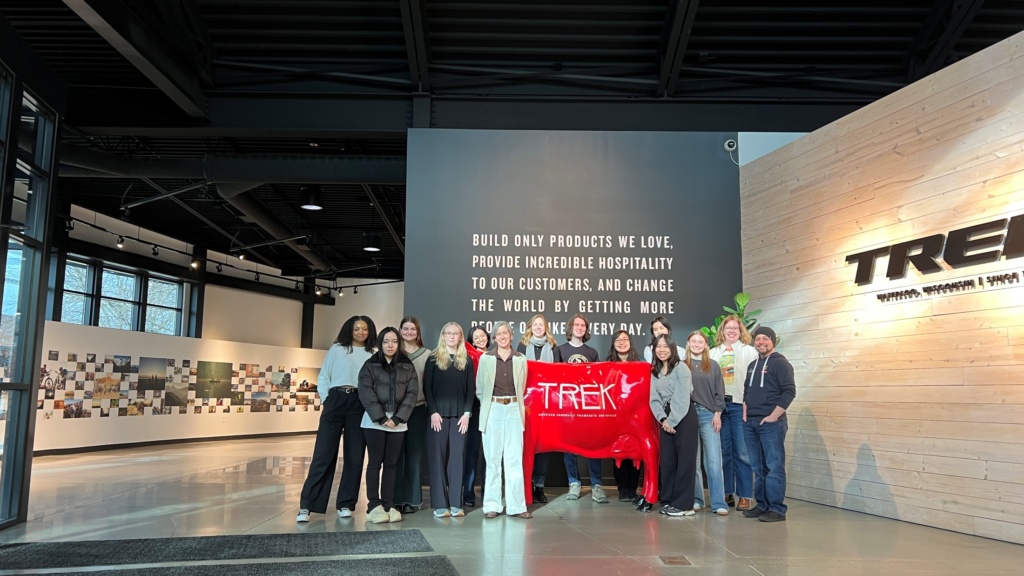By Thomas Jilk
 An alum of the Information School’s MA in Library & Information Studies, Leah Ujda MA’07 has led user experience (UX) design and research for over a decade at firms like Indeed and Grafana Labs. Ujda recently returned to campus to serve as UX Professor of Practice at CDIS, a role in which she teaches UX and professional development courses and builds partnerships between student organizations and leading companies.
An alum of the Information School’s MA in Library & Information Studies, Leah Ujda MA’07 has led user experience (UX) design and research for over a decade at firms like Indeed and Grafana Labs. Ujda recently returned to campus to serve as UX Professor of Practice at CDIS, a role in which she teaches UX and professional development courses and builds partnerships between student organizations and leading companies.
“The idea of being able to come back and help students in CDIS figure out how to use their skills in UX professions was very appealing to me,” she said.
In a recent conversation, Ujda discussed her career path, her new role, and the importance of UX—and offered guidance for students navigating the early stages of their careers. The following conversation has been edited for length and clarity.
You served in multiple library roles after graduating from the iSchool. How did your time as a librarian influence your approach to UX?
The things I learned in my master’s program that allowed me to make the career pivot from libraries to UX were information architecture, database design, and metadata. I used those skills as a Digital Librarian for the Wisconsin Center for Education Research and as a Metadata Librarian for University of Wisconsin Digital Collections Center before transitioning to industry roles in UX research and design.
Unexpectedly and delightfully, what I learned about asking questions while working at a reference desk translated well to doing research with users. When you’re doing user research for the purpose of product development, you’re asking people about what they do, what’s going well, and what they wish they could do but currently cannot. That’s not so different from a student who comes to a reference desk and says they need three peer-reviewed articles on gun control laws, for example. You’re asking many of the same questions: What are you trying to learn? What do you already have? What do you still need? It’s all about user needs.
Why is UX important, and what is an example of good (or bad) user experience from your own life?
The quality of user experience is critical because it can make the difference between positive and negative perceptions of a product or service and ultimately determine its success in the market. Good UX designers take a human-centered design approach to whatever they’re building, whether digital, physical, or service-based, and this leads to a better product in the end. Having empathy for the people engaging with what you create is essential; you can’t meet their needs unless you know what those needs are.
As an example of bad UX, my husband bought what seems like the world’s largest TV recently, and the built-in menu on it makes no sense. Simple navigations, like going from Netflix to Hulu, take more time and clicks than they should. We have to use a PlayStation controller to navigate because it’s the only thing that works logically, which is just bizarre.
On the other hand, I have always enjoyed the user experience of Pokémon Go. During the beginning of the pandemic, my sister and I started playing Pokémon Go with my nephew. Now he’s moved on, but my sister and I still play. It gives you tasks, lists, a sense of accomplishment, and it ties the digital experience to the real world in a way that I love. For example, local weather data is incorporated to make certain characters appear more frequently based on conditions outdoors in your location. I also really appreciate how the game incorporates contextual navigation -— a traditional static set of options for what a user can do on a page is replaced with a subset of options that are relevant given the page or part of the screen a user is engaged with. You only see what you need when you need it.
What is your approach to teaching and what kinds of courses will you teach at CDIS?
Collaboration is extremely important to me in instruction because in my experience, it was always important for both team leadership and product design. I think it serves students well to graduate with experience and practice being collaborative on projects both with others who have the same areas of expertise as them, and their cross-functional colleagues.
I taught a course this semester (LIS 640) designed to help iSchool students with their job searches, and almost every week, there are opportunities for them to work in small groups, review each other’s work, and share critiques and feedback. In the Computer Sciences capstone (COMP SCI 620) that I’m shadowing this semester and will be teaching in the fall, students spend a whole semester learning how to work successfully on a team to solve problems for real organizations.
Can you sum up everything that your role involves?
There are three component parts. The first is teaching; I’ll be teaching the CS capstone moving forward and UX courses in the iSchool starting later this year. Second, I’ll be supporting non-credit learning opportunities for students interested in UX. For example, I serve as an advisor for student organizations like WebLabs, Design Interactive, and the iSchool UX Club. Third, I’ll be working with Justin Hines, CDIS director of corporate relations, to build lasting partnerships with industry, specifically organizations interested in design and user experience.

How can UX serve as a bridge between different disciplines in CDIS?
UX brings together people from different disciplines naturally, because practitioners of UX work together in many different contexts, some more technical than others.
Some implement designs for accessibility, a focus computer science students might gravitate toward because they’re comfortable writing code and working with interfaces. Others might be more drawn to discovery research, figuring out what users actually need, rather than how to build it. Those students might come from the iSchool, but can also include people from a wide range of backgrounds. A lot of digital products include data visualization in their feature sets, so I can see statistics and data science students becoming curious about UX and visual design fundamentals as they explore career options. I’m excited to help find opportunities in the UX field for students across CDIS programs.
What advice do you have for students interested in UX as they consider their future careers?
I would encourage students not to be intimidated by products or projects that they don’t initially feel a personal connection to. For example, when I was Interim Head of UX at Grafana, my team was designing data visualization products used by site reliability engineers and DevOps teams. That group of users and their needs was outside of my comfort zone at first, but ended up being a fascinating and rewarding experience.
Students should keep in mind that research in human-computer interaction and design shows the fundamentals of UX—having empathy for users, making good information architecture decisions, embracing an iterative approach to your work—matter enormously, whether you’re working on a niche technical product or a consumer-facing app. CDIS is the perfect place for students to learn those fundamentals.
Learn more about industry partnerships with CDIS.
Learn about the UX Design Capstone Certificate from the Information School.